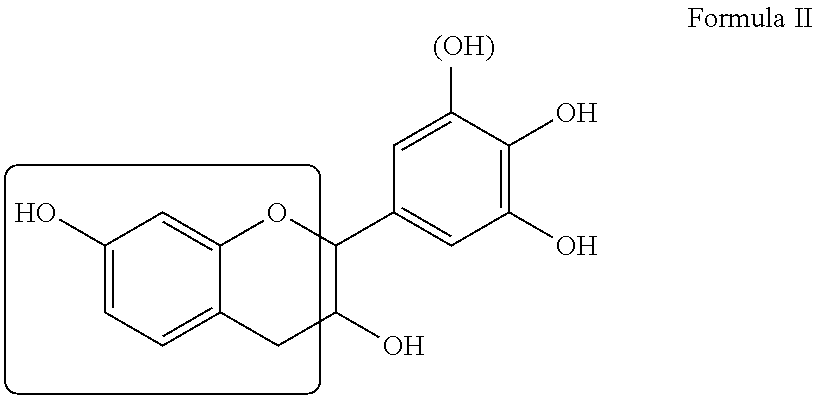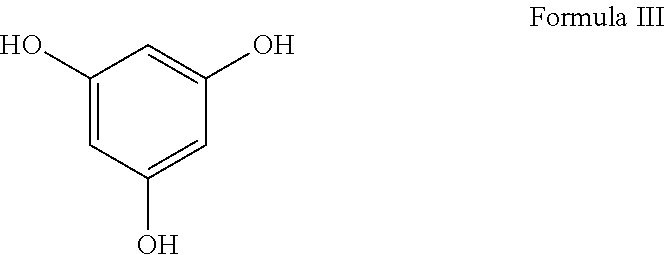Composite products made with lewis acid catalyzed binder compositions that include tannins and multifunctional aldehydes
a technology of lewis acid and composition, applied in the direction of liquid surface applicators, pretreatment surfaces, coatings, etc., can solve the problems of reducing the shelf life of resin, reducing the product strength, and affecting the health of humans and the environment, so as to improve the composition of binder
- Summary
- Abstract
- Description
- Claims
- Application Information
AI Technical Summary
Benefits of technology
Problems solved by technology
Method used
Image
Examples
examples
[0116]In order to provide a better understanding of the foregoing discussion, the following non-limiting examples are offered. Although the examples may be directed to specific embodiments, they are not to be viewed as limiting the invention in any specific respect. All parts, proportions, and percentages are by weight unless otherwise indicated.
example i
[0117]Black wattle tannin, glyoxal, and sodium silicate were combined with one another to produce the binder compositions. The black wattle tannin was purchased from Bondtite Adhesives Ltd. and was product number 345. The glyoxal was a 40 wt % aqueous solution (Product Number 128465) and was purchased from Sigma Aldrich. The sodium silicate was a 10 wt % aqueous solution (Product Number 338443) and was purchased from Sigma-Aldrich.
[0118]A series of binder compositions (Ex. 1-16) were prepared according to the following procedure. The pH of 13.5 g black wattle tannin (50 wt % aqueous solution) was adjusted to the desired pH value, which ranged from 7.9 to 12.3, depending on the particular example, by adding a sufficient amount of a 50 wt % aqueous sodium hydroxide solution. An Orion 2 Star pH meter was used to monitor the pH of the black wattle tannin. To the black wattle tannin was added 1.5 g glyoxal (40 wt % aqueous solution) and 1.5 g sodium silicate (10 wt % solution) to provide...
example ii
[0121]The effect of varying the amount of sodium silicate was determined. More particularly, a series of examples (Ex. 17-27) were prepared having the same amount of black wattle tannin and glyoxal, but varying the amount of the sodium silicate. The binder compositions were prepared in the same manner as Examples 1-16. The test results are shown below in Table 2.
TABLE 2Effect of Lewis Acid on Gel Time TestpH of BlackSodiumSodiumWattleSilicate (10 wtSilicate (wt %gel timeExampleTannin%, g)solid basis)(min)1710.070.30.41>301810.070.390.539.61910.070.450.616.22010.070.50.682.52110.070.50.682.52210.070.60.821.42310.070.60.821.52410.070.751.020.62510.030.751.020.52610.031.52.040.32710.031.52.040.3
[0122]As shown in Table 2, when the amount of sodium silicate fell below an amount somewhere between about 0.41 wt % and about 0.53 wt % on a solids basis, the binder composition did not gel within 30 minutes. When the sodium silicate was present in the binder composition in an amount of about 0...
PUM
| Property | Measurement | Unit |
|---|---|---|
| wt % | aaaaa | aaaaa |
| temperatures | aaaaa | aaaaa |
| temperatures | aaaaa | aaaaa |
Abstract
Description
Claims
Application Information
 Login to View More
Login to View More - R&D
- Intellectual Property
- Life Sciences
- Materials
- Tech Scout
- Unparalleled Data Quality
- Higher Quality Content
- 60% Fewer Hallucinations
Browse by: Latest US Patents, China's latest patents, Technical Efficacy Thesaurus, Application Domain, Technology Topic, Popular Technical Reports.
© 2025 PatSnap. All rights reserved.Legal|Privacy policy|Modern Slavery Act Transparency Statement|Sitemap|About US| Contact US: help@patsnap.com



